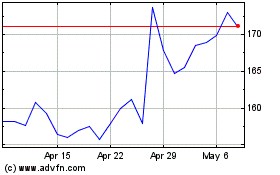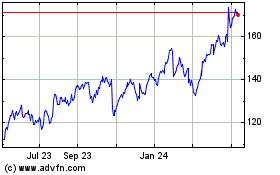Inside Samsung's plans to make cars an information and
entertainment system on wheels
By Timothy W. Martin
This article is being republished as part of our daily
reproduction of WSJ.com articles that also appeared in the U.S.
print edition of The Wall Street Journal (November 13, 2018).
SUWON, South Korea -- If cars do become the next smartphone -- a
full-blown information and entertainment system but on wheels --
Samsung Electronics Co. may have a leg up on its competitors.
Samsung, the world's largest smartphone maker, was a relative
nobody in the auto industry until it announced an $8 billion deal
two years ago to acquire Harman International Industries Inc., a
U.S.-based automotive-technology manufacturer.
Now, paired up with Harman, the South Korean technology giant is
one of the biggest players in the market for the top-of-the-line
"infotainment" systems that are in cars today. Its plan is to
create a "digital cockpit" -- a high-tech revamp of a car's
dashboard designed for an ultra-connected vehicle, with a bank of
screens from one side of the car to the other. The screens would
allow drivers to control everything from the interior's temperature
to the temperature of the refrigerator back home, and passengers to
surf the web and watch streaming videos.
A commercialized Samsung digital cockpit is still at least
several years away from reaching the market, meaning 2021 or 2022
car models, industry analysts say. In the longer run, Samsung is
competing to be the designer of choice -- and components supplier
-- for the interior of driverless cars. "We won't be driving
anymore, so how will we spend time in the car?" says Luca De
Ambroggi, a senior AI and auto researcher at IHS Markit, a market
researcher.
Samsung's ambitions will be helped by the arrival of
next-generation 5G wireless networks that will result in faster
download speeds. In August, Samsung said it would invest more than
$22 billion over the next three years in areas like 5G, artificial
intelligence and auto-technology components. "The connected car is
one of the most anticipated breakthroughs in technology. Yet this
breakthrough can't happen without 5G," says Lee Won-sik, a former
Samsung smartphone user-interface designer, who now leads the
company's automotive-electronics research and development team.
The distraction issue
Approaches like Samsung's digital cockpit, seeking to replicate
the functions of a smartphone, face a serious obstacle: safety
concerns. In recent years, J.D. Power and Consumer Reports, among
others, have called attention to the potential distraction of
in-car multimedia systems.
Because of such safety concerns and technological hurdles, most
cars today don't wield the full range of features packed on a
smartphone. For instance, drivers trying to search for artists or
songs on Spotify are generally blocked from doing so. Similarly,
some car makers have apps offering in-vehicle ordering at
restaurants, but the full menu can't be viewed while driving.
"Car makers are trying their very best to find that balance
between adding features in the vehicle and doing so safely," says
Mo Al-Bodour, who researches connected vehicles at SBD Automotive,
a market research and consulting firm. A Samsung spokesman declined
to comment.
The Android advantage
Google parent Alphabet Inc.'s push into providing its Android
operating systems for connected cars could hand Samsung a huge
advantage, according to auto-industry consultants, because the
Korean company is the largest Android handset maker. Last month,
the Renault-Nissan-Mitsubishi Alliance, which together sells more
vehicles than any other auto maker, chose Google to provide its
operating system with a 2021 debut.
"Samsung can redirect their existing smartphone teams to
automotive applications and other use cases," says Roger C.
Lanctot, the director of automotive connected mobility for Strategy
Analytics, a market researcher. "That Samsung already understands
how to ensure that hundreds of millions of connected devices
function properly and effectively is a significant advantage."
For example, Samsung figured out how to synchronize Android
across three different displays in the digital cockpit, a challenge
because previously the screens were often running on different
chipsets, if not operating systems. This development reduces costs
to auto makers.
Samsung has another advantage in the close ties that Harman had
forged with dozens of auto makers long before the Samsung
acquisition closed last year. Samsung executives have said they
want Harman to remain independent, and auto-industry watchers say
Harman hasn't veered much from its pre-acquisition path.
Harman's products include connected-car software that lets
drivers use one of several digital assistants, like Amazon.com
Inc.'s Alexa or Samsung's Bixby. Its software also uses artificial
intelligence to predict a driver's podcast preferences, and parents
can be alerted if their child drives outside of a specified
area.
Because of Harman's prior success, Samsung is already a
significant player in the connected-car business. The
Samsung-Harman duo was the second-largest auto infotainment
supplier in 2017, with $4.8 billion in revenue, according to
Strategy Analytics, second only to Panasonic and Sanyo's $5.1
billion.
As the competition intensifies, some auto-industry experts
question whether consumers actually want all of the bells and
whistles possible in the connected-car era.
"Right now you have so many features in the cars, people don't
know what they have," says Carsten Isert, a senior director of
smart mobility at research and consulting firm Gartner Inc. "Home
appliances from the car? I'm not sure how many people are going to
use that."
Mr. Martin is a Wall Street Journal reporter in Seoul. He can be
reached at timothy.martin@wsj.com.
(END) Dow Jones Newswires
November 13, 2018 02:47 ET (07:47 GMT)
Copyright (c) 2018 Dow Jones & Company, Inc.
Alphabet (NASDAQ:GOOG)
Historical Stock Chart
From Mar 2024 to Apr 2024

Alphabet (NASDAQ:GOOG)
Historical Stock Chart
From Apr 2023 to Apr 2024
